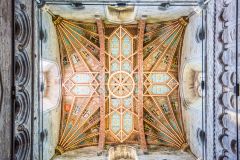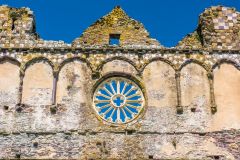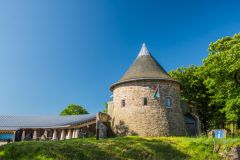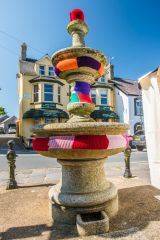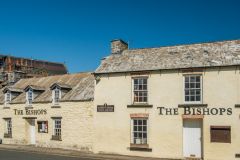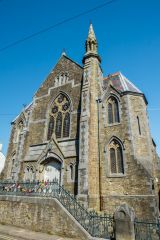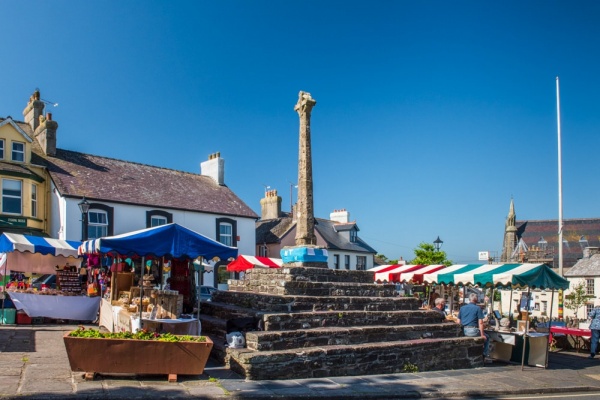
St Davids is the smallest city in the UK, with a population of under 2000. Though technically correct, calling St Davids a city does not convey the true charm of this delightful historic location that has more the feel of a large village. Having said that, there cannot be many villages or, indeed, cities, that cram so much history into such a small space. Within a few minutes walk are a superb medieval cathedral, a bishop's palace, a medieval gateway, and a 14th-century market cross.
A longer walk from the city centre brings you to St Non's Chapel, where Non gave birth to St David. A few steps from the chapel ruins is a holy well dedicated to St Non. A bit further away on St Davids Head is an Iron Age promontory fort and hut circles, within a short stroll of Coetan Arthur burial chamber. And that's just scratching the surface of what St David's has to offer.
St Davids is special; it has no traffic lights and none of the ubiquitous chain stores that you find in so many other popular tourist destinations.
The village ... sorry ... city is centred on Cross Square, the site of a weekly market. On a traffic island in the middle of the square is the 14th-century market cross, set upon a stepped plinth.
About St David
St David (Dewi Sant in Welsh) was born in the late 5th or early 6th century in the south-west corner of Wales. Estimates of his birth date range from AD 462 to AD 515. The traditional site of his birthplace is just south of the modern city of St Davids at St Non's Chapel.
Contemporary details of his life are scanty and much of what we know comes from a much later 11th-century source of dubious authenticity. David's mother was Non, who gave birth to him in a thunderstorm after she was raped by Sandde, a prince of Powys and son of Ceredig, the King of Ceredigion.
David was educated by St Paulinus of Wales at Whitland monastery in Carmarthenshire. He founded a dozen monasteries in southern Wales and did much to spread Christianity throughout Wales. Around AD 550 David founded a monastery at what is now St Davids, near the site of his birth. When he finally died after passing 100 years in age he was buried in the grounds of his monastery (the traditional date is 1 March 589). Over the following centuries, the monastery was sacked on at least 10 occasions by Norse raiders.
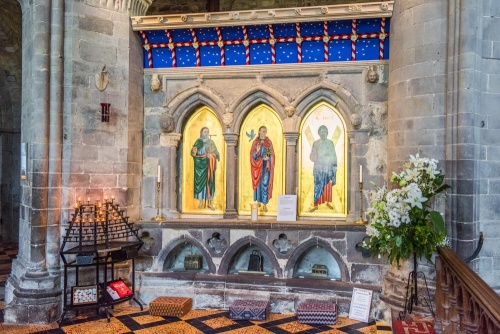
During the medieval period, David's shrine became an increasingly popular destination for pilgrims, and it was said that two pilgrimages to St Davids equalled one pilgrimage to Rome. David was sanctified in 1123 and shortly thereafter he was proclaimed the patron saint of Wales. The importance of St David's shrine was emphasised by the visits of several monarchs, including William the Conqueror, Henry II, and Edward I.
You can still visit St David's shrine, which stands within the superb medieval cathedral that grew up around the saint's original monastery.
A settlement grew up around St David's monastery called Tyddewi, which translates from the Welsh as 'David's House'. That settlement grew in importance during the medieval period as pilgrims flocked to visit St David's shrine in the Cathedral. Despite the flow of pilgrims, St Davids never grew to any great size and retained its village atmosphere.
St Davids Cathedral
The cathedral we see today was built in the 12th century on the site of St David's 6th-century monastery by Peter de Leia, the third Norman Bishop of St Davids. The Norman architects struggled to cope with the wet ground, and even today the nave pillars lean at a striking angle due to the soft underlying ground.
The cathedral is full of historical features and the tombs of important Welsh nobles and church officials. Near the high altar is the shrine of St David, while on either side of the altar steps are mortuary chests holding the bones of Welsh saints. Beside St David's shrine is the tomb of Edmund Tudor, the father of Henry VII.
In the north transept is the shrine of St Caradoc, an 11th-century prince of Brecknockshire who became a religious hermit. Other famous people whose memorials fill the cathedral include Geraldus Cambrensis (Gerald of Wales), the 13th century monk and chronicler, and Rhys ap Gruffydd (Lord Rhys).
More about St David's Cathedral >>
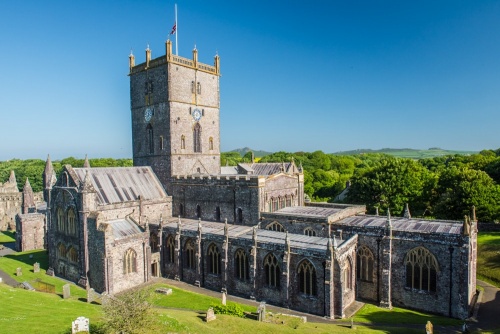
St Davids Bishop's Palace
Beside the cathedral stands the ruins of the Bishop's Palace, built by Bishop Henry de Gower around 1327. When the Normans invaded Wales in the late 11th century they established their own bishops to replace the Welsh. They built a bishop's residence beside the cathedral, defended by a motte and bailey fortification. They later abandoned the motte and bailey in favour of a high stone wall encircling both the palace and the cathedral.
The Norman Bishops of St David were not only spiritual leaders, but political and military leaders as well, exercising enormous power in their territory.
From 1328 Bishop de Gower extended the Norman palace in grand style, creating a Great Hall, the centre of palace life, and a range of ostentatious public rooms. To this, he added the Great Chamber, the centrepiece of a private suite meant to impress visitors. Part of the private quarters was a tower housing a private garderobe; creating an early form of ensuite accommodation.
Most of the Bishop's Palace rooms are now roofless, but the architecture is superb, and the 14th century Grand Gatehouse impresses visitors today just as it did when Bishop de Gower had it built over 650 years ago.
The Bishop's Palace is now in the hands of CADW.
More about St Davids Bishop's Palace >>
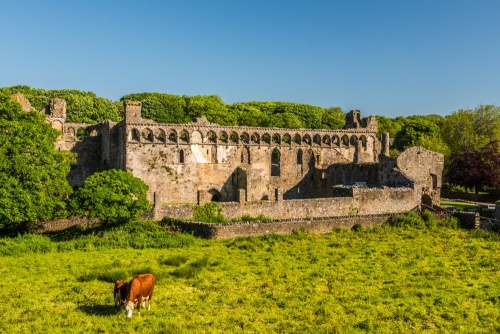
The Cathedral and Bishop's Palace stand within the Cathedral Close, inside which is a complex of historical buildings including the Canonry, Treasury, and Cloister Hall. Between the Cathedral Close and the market square is Porth y Twr, a 14th-century gateway with an attached bell tower. It is the only one of four medieval gateways to survive.
Inside the tower is a collection of carved stones ranging from the 5th to the 12th centuries. Perhaps the most historically important stone is the Abraham Stone, commemorating two sons of Bishop Abraham, killed by Vikings in AD 1080.
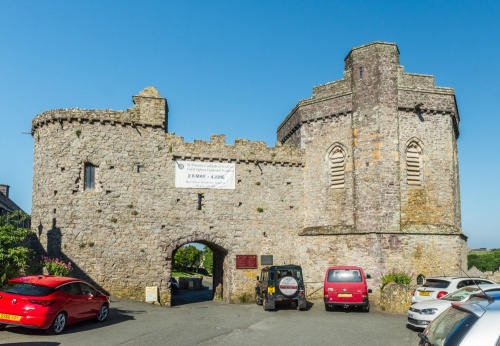
St Davids Heritage Buildings
The best place to start exploring St Davids is Cross Square, named for the striking medieval market cross. The stepped base that supports the cross shaft is well worn, the marks supposedly made by the rope used to pull the local lifeboat from its storage place in the grounds of the Cross Hotel. The hotel was originally a merchant's house and dates to at least 1766.
The market cross was the focal point for twice-weekly markets, and as late as 1939 cabbages were sold from the steps of the cross every St David's Day. Beside the cross is a small memorial garden dedicated to the fallen of the two World Wars. Near the cross is a flagpole erected to honour the crew of the lifeboat Gem, who were lost at sea. On the other side of the cross is a striking granite water fountain given by Captain Roach of Belmont in 1912.
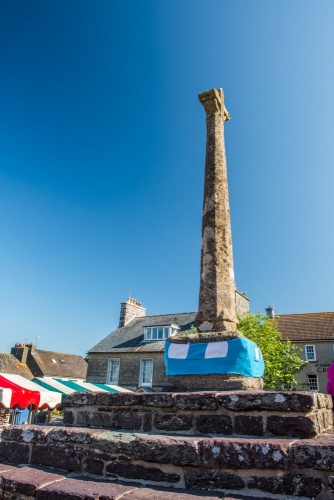
There are several old chapels and churches within a few minutes stroll of Cross Square. The oldest is the Ebeneezer Welsh Congregational Chapel on Nun Street, built by subscription in 1815 and restored in 1871.
Just a few years younger is the former Bethel Methodist Chapel on Goat Street, now a gallery. The Tabernacle Presbyterian Chapel, also on Goat Street, is an impressive Gothic Revival building designed in 1877 on the site of an earlier 1817 chapel.
The Seion Baptist Chapel on New Street was opened in 1843 and is linked to an early 20th-century schoolroom. And finally, the Roman Catholic Church on Town Hall Lane was built in 1866 as a concert hall and community library. It served briefly as the Town Hall, as a school, and as a cinema before becoming a church in 1962.
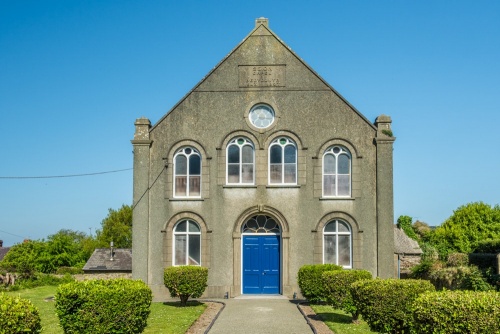
There are several interesting old inns in the centre of St Davids, including the Farmers Arms on Goat Street, which dates to at least 1818 and was originally two separate cottages. On Cross Square is The Bishops, named not for the Bishops of St Davids but for a group of rocks off St Davids Head.
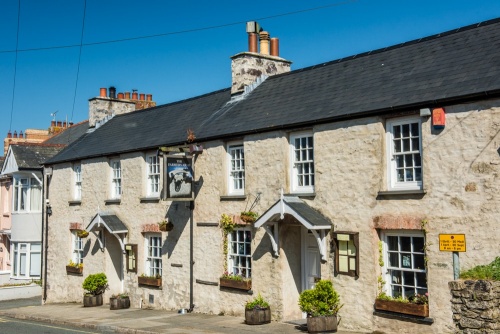
Nearby Attractions
St Non's Chapel & Holy Well
A pleasant stroll from the centre of St David's leads you to St Non's Chapel, a roofless medieval chapel on the traditional site of St David's birth. In a corner of the chapel is a 6th-century cross. The footpath to the chapel leads directly past a holy well whose waters are said to heal eye problems. A few steps from the holy well and chapel is a Catholic retreat centre and in the grounds of the centre is the Chapel of Our Lady & St Non, a modern chapel built in 1934 but incorporating carved stones from several medieval and earlier chapels in the area.
More about St Non's Chapel & Holy Well >>
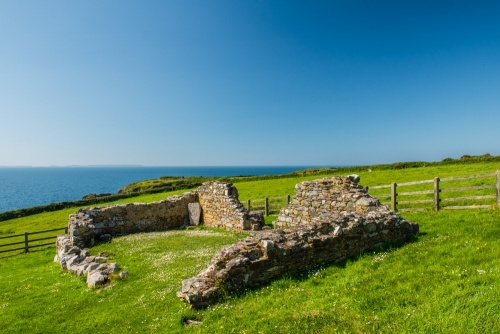
St Davids Head Hut Circles
Just north of St Davids is Whitesands Bay, with a beautiful sandy beach that is said to be the site where St Patrick, a pupil of St David, sailed on his expedition to bring Christianity to Ireland. If you follow the coast path north of Whitesands Bay you come to St David's Head, a spectacular rocky headland used by Iron Age people to create a promontory fort known as Warrior's Dyke, with high stone banks cutting the headland off from the mainland. Within the fort are hut circles that were in use as early as 1000 BC and probably also during the Roman period.
More about St Davids Head Hut Circles >>
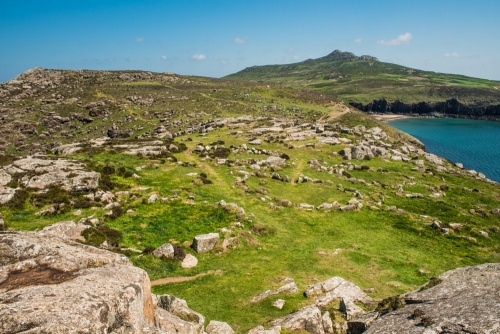
Coetan Arthur Burial Chamber
A very short walk from St Davids Head is Coetan Arthur (Arthur's Quoit), a Neolithic burial chamber built around 3000 BC. The burial chamber boasts a huge capstone over 18 feet long and 8 feet wide.
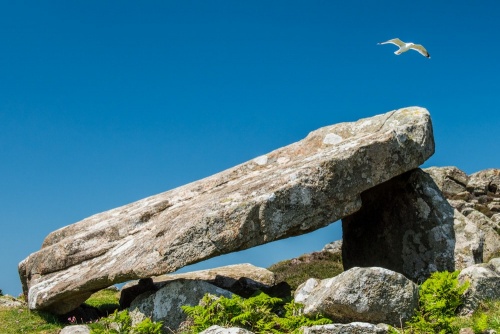
The Pembrokeshire Coast Path runs along the spectacular coastline, making St Davids an ideal centre for a walking holiday. Off the coast is Ramsey Island, known for its huge bird population. The island is owned by the RSPB and boasts stunning scenery, bird cliffs, and a large colony of grey seals. Tourist boats sail around the island from St Justinians, which is also home to an RNLI lifeboat station built in 1869.
Just west of St Davids is Felin Isaf (Lower Mill), dating to at least 1326 when it was one of three mills owned by the Bishop. On the eastern edge of the city is Twr y Felin, a tower windmill built in 1806. It fell out of use in 1906 and was converted into a hotel.
This is just a brief overview of all there is to see in St Davids. Our family have visited twice and I have to say its one of the most beautiful and enjoyable historical places in Britain. The sense of history is pervasive, but what makes St David's so enjoyable is that it manages to retain the atmosphere of a village, with wonderfully picturesque and unique shops and houses. It is fabulously enjoyable to explore the centre of the city and discover the fascinating historic sites that surround the city itself.
At the east end of High Street is Oriel Y Parc, a combination art gallery and tourist information centre operated by the National Museums and Galleries of Wales. Oriel Y Parc makes an excellent first stop for picking up local maps and brochures and finding out more about St Davids.

About St David's
Address: St Davids,
Pembrokeshire,
Wales
Attraction Type: Town
Location: On the A487 north-west of Haverfordwest
Website: St David's
Location map
OS: SM753251
Photo Credit: David Ross and Britain Express
POPULAR POSTS
HERITAGE
 We've 'tagged' this attraction information to help you find related historic attractions and learn more about major time periods mentioned.
We've 'tagged' this attraction information to help you find related historic attractions and learn more about major time periods mentioned.
Find other attractions tagged with:
NEARBY HISTORIC ATTRACTIONS
Heritage Rated from 1- 5 (low to exceptional) on historic interest
St David's Cathedral - 0.2 miles (Cathedral) ![]()
St David's Bishop's Palace - 0.3 miles (Historic Building) ![]()
St David's, Chapel of Our Lady & St Non - 0.5 miles (Historic Church) ![]()
St Non's Chapel and Holy Well - 0.6 miles (Historic Church) ![]()
Coetan Arthur (Arthurs Quoit) Burial Chamber - 2.5 miles (Prehistoric Site) ![]()
St David's Head Hut Circles - 2.5 miles (Prehistoric Site) ![]()
Carreg Samson Chambered Tomb - 7.9 miles (Prehistoric Site) ![]()
Skomer Island - 9.9 miles (Countryside) ![]()
